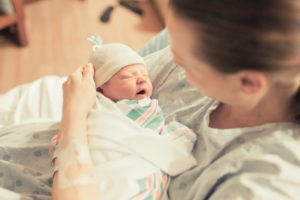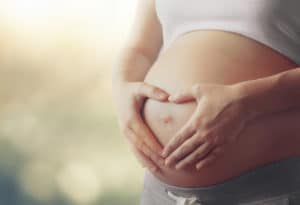Table of contents
Birth To Order – The Pros And Cons Of An Elective C-Section
Every fifth birth in Germany is now a cesarean section. One reason for the increasing number is certainly that not every woman wants to give birth the good old way. About six percent of all expectant mothers have their child delivered by surgery, even after a problem-free pregnancy. What has long been commonplace in countries such as South America or England is still a source of debate in this country.
Should expectant mothers really be able to get a doctor to remove their baby without medical necessity? For a good six years now, German doctors have been giving their patients more say in this matter. One of the main reasons that trigger a woman’s desire for a cesarean section – known medically as a sectio – is fear of the pain of childbirth. Many women also fear the overuse of the pelvic floor muscles during vaginal birth, which can be responsible for later postpartum problems, bladder weakness or sexual problems. Talking to midwives and doctors, however, can allay many of a woman’s fears and inform her, for example, about the good medical options for a natural, but pain-free birth.
Cesarean Section For The Desired Child
Celebrities and career-conscious women such as Madonna, Claudia Schiffer and Verona Feldbusch prefer to give birth to their offspring on the operating table. In general, more and more couples want to leave as little as possible to chance when it comes to having their dream child. They see a C-section as the lowest risk for their baby. It experiences less birth stress and possible complications such as oxygen deficiency, a prolapsed umbilical cord or the use of a suction cup or forceps are ruled out.
However, the personal considerations of the expectant mother are more decisive than weighing up all the advantages and disadvantages. Especially during childbirth, psyche and attitude play a major role. If she is willing to work and perhaps suffer during the birth, the conditions are different than if she gives birth against her will. Because then there is a lack of important and driving energy, which may lead to complications. However, doctors may not agree to an elective cesarean section without first informing the woman of the possible risks. In some cases, however, doctors are accused of not sufficiently questioning the mothers’ motives, sometimes seeking or constructing a possible indication first. Many clinics have therefore had to defend themselves against the suspicion that they are increasing their C-section rates out of economic interests. After all, at around 1,600 euros, a C-section costs almost three times as much as a normal birth. The health insurance companies, however, do not pay for the desired cesarean section: The woman has to pay the difference to a normal birth herself.
Risks And Side Effects
Although the mortality rate of mothers after a cesarean section is very low today – about 1 in 60,000 – it is an open abdominal operation with all the surgical risks. Thromboses (blood clots) or embolisms (blood vessel blockages) can occur afterwards, and the wound can become infected or heal unsightly. Healing is also naturally slower than after a vaginal birth. So the mother cannot take full care of her baby right away. However, surgical sutures are now very fine and incision techniques are gentle. For example, most cesarean surgeons today work their way to the unborn baby using the Israeli Misgav Ladach technique (named after a hospital in Jerusalem): In this “gentle section,” only a small incision is made in the lower abdomen and the rest of the tissue is opened with the fingers. This allows it to grow together naturally more quickly and leaves less suture material in the woman’s body. Nevertheless, the uterus is no longer intact after a cesarean section. Therefore, increased problems can occur with each subsequent pregnancy: from placental disorders, uterine rupture, pregnancy outside the uterus, to miscarriage.
Consequences For The Child
If the child does not take the natural route through the birth canal, it may suffer from so-called “wet lungs” or the dangerous respiratory distress syndrome RDS after birth. Often, babies are delivered two weeks before their due date, before their lungs have fully matured – and, moreover, from a uterus still in labor. In a normal birth, amniotic fluid is squeezed out of the unborn child’s lungs during labor and on its way through the birth canal. Only this allows the lungs to subsequently fill with air. In a cesarean birth, the child’s lungs are not prepared for the external conditions. The children therefore sometimes have to be ventilated for several days before they are able to do so themselves. Thus, they must be treated similarly to premature infants, who receive additional lung maturation medications. In addition, midwives point out that bonding between mother and baby and the first breastfeeding after a C-section often do not work out so well either.
An Irreversible Experience
The natural onset of labor at the end of pregnancy is usually the optimal time for the baby to come into the world. If the birth proceeds without major interventions and is accompanied sensitively, it is a wonderful and intense experience for mother and child. Bringing the child into the world under her own power can give a woman great inner strength and self-confidence. This in turn is an important preparation for the new role as a mother. We therefore see it as one of our most important tasks to encourage women to trust in their own natural childbearing abilities.
Background Knowledge: Cut For An Emperor
Until recently, it was mistakenly believed that Gaius Julius Caesar was the first surviving “cut” to be taken from his mother’s womb, thus becoming the namesake of “sectio caesarea” (Latin: caedere = to cut). Among aristocrats of the Renaissance, the caesarean section was therefore considered the royal way of birth.












4 thoughts on “Caesarean Section – Pros And Cons”